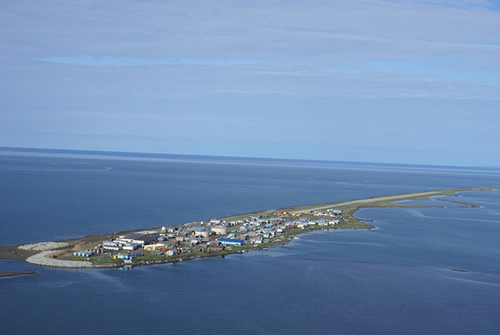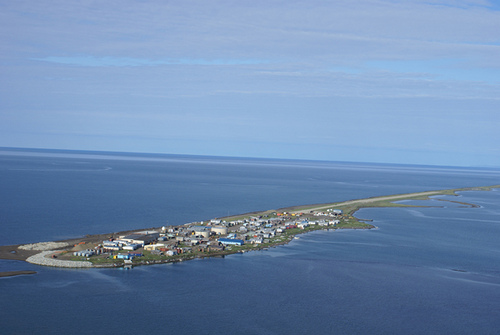Winning their landmark climate suit against energy companies is just one challenge
Following their appearance in a San Francisco Federal Appeals Court this week, Climate Watch contributor Amy Standen was the only journalist to sit down with members of the Kivalina delegation before their return home.

As a group of nine Alaskan natives returns to their coastal village after their day in court, it seems that their plight is about more than getting money to pay for a move to higher ground. It’s an interesting microcosm of the climate conundrum: The past isn’t prologue anymore. History is a faulty crystal ball. How climate change will affect a specific place is anyone’s best guess. And in the case of Kivalina — and likely, many other places — residents’ visions of the future may not line up with those of scientists.
In the past, Kivalina– which lies at the tip of a narrow barrier island off the coast of Alaska – was buffered from storms by a thick layer of ice around its perimeter. But now the ice is melting. Every time a storm hits, many of Kivalina’s 400 residents take shelter in a local elementary school, hoping the waves will spare them. Everyone agrees: The village must relocate.
Moving Kivalina will likely cost between $180 and $400 million, according to the US Army Corps of Engineers. So far, it’s not clear where that money is going to come from, which is one reason Kivalina is suing ExxonMobil, Chevron USA, and 22 other gas, electric, and power companies whose greenhouse gas emissions, according to the suit, led to Kivalina’s woes.
But money isn’t the only obstacle. There’s also the question of where to go. The native Inupiat community in Kivalina has its preference. The Corps of Engineers, which dispenses advice on flood safety, has a different one. But given the inherent instability of climate change, how relevant is either prediction?
I met up with Enoch Adams, Jr., a member of the Kivalina delegation, at his attorney’s office in downtown San Francisco.
How did the Corps go about choosing a relocation site?
“The Army Corps of Engineers studied six different sites. They did storm surge studies using 100-year flood [scenarios] and 500-year floods. And they chose two sites that would meet the 500-year flood plain.”
So why has the Kivalina community chosen a different site?
[module align=”left” width=”half” type=”pull-quote”]”…traditional knowledge needs to be given the same respect that their scientific data gets.”[/module]
“We told [USACE] a story of a little girl, back before the turn of the century, who happened to be some of our people’s grandmother and great-grandmother. The area had flooded, and they had to move to higher ground, using a skin boat, a boat they use for traveling. She was a little girl at the time, probably about 15. She said she happened to look back, to the place where Kivalina was and it was flooding, and she saw one area that was not flooding at all. And that’s the site the community has picked.
“The site that the community picked would answer the 100-year flood [scenario], but the Army Corps of Engineers is concerned it might not meet the 500-year flood plain. But this is their projection, their prediction. And sometimes they’re so caught up in the science part, they don’t realize that all they’re doing is predicting, which is a 50-50 thing. Their guesses are as good as ours.”
How do you think this will be resolved?
“There seems to be a change — and I hope this continues — that the federal government is looking for ways to have traditional knowledge be as respected as their scientific data.
“A lot of our knowledge is based on observation over years, and stories that are told from father to son, mother to daughter, over generations. We use this knowledge to do our subsistence hunting, our fishing, our gathering. We know it to be accurate, because we depend on that knowledge as a people, to survive, and to thrive as a community. I hope that the federal government recognizes soon, and it looks like they will, recognize that traditional knowledge needs to be given the same respect that their scientific data gets.”
Amy Standen is a reporter for KQED’s award-winning science & environment initiative, QUEST.
6 thoughts on “Threatened by Rising Seas, Alaskans Ponder Where to Move”
Comments are closed.


Moving towns in Alaska has happened before. In the aftermath of the 1964 Alaska quake, the Lions Club helped relocate company town of Port Wakefield on Raspberry Island and neighboring Afognak, a Native village. Both were combined to create Port Lions, which had a deep-water port and great elevated land for the townsite. Afognak was built right on the beach. When Kodiak Island sank 4 feet as the result of the quake, all the homes were exposed to ferocious winter weather.
Great historical note, Mike. Thanks!
No, I am sorry, “traditional knowledge” does not get the same respect as scientific knowledge.
According to Rick Perry’s “traditional knowledge”, sea level won’t go up because God promised Moses that He would never destroy the Earth by flood again. Every time you see a rainbow (except when gays are displaying one), is “proof” that rising sea level won’t flood anything.
I appreciate that the Inuit traditional knowledge is of a completely different degree than that of Rick Perry. But CO2 is now higher than it has been in 10 million years, long before there were any humans any where.
There has been no statistically significant global warming since at least 1998. There has been cooling for the last 7.5 yrs. Global sea levels are *down* 6 mm over the last year–double the rate of rise seen prior to that. None of this comports with the global warming hypothesis, nor was is predicted by any of the climate models.
Finally, there is zero evidence that any of the warming that has occurred in this century is due to human activities. The causality between human-produced carbon dioxide and global temperatures is based on a logical fallacy, the appeal to ignorance–the ‘what else can it be?’ argument. This is evident in both the IPCC documents, and the equivalent material on the NAS website. The changes in the ice coverage near this Alaskan village cannot be scientifically attributed to the carbon released by these companies or any other.
That doesn’t mean we, as a society, shouldn’t help them. But, if we do, it should not be on the basis claimed in the suit; it has no scientific validity.
Gene,
Thank you for bringing the truthiness from Faux News to our sadly misinformed academic community. I’m sure if we spend more time listening to rabid Oxycontin addicts head Rush as you do, we will learn to behave better.
Carl,
You have illustrated how I first came to suspect the AGW hypothesis was bunk…it was not any news outlet, nor any talk show host… it was the unending stream of ad hominem attacks (like yours) by the alarmists on anyone and everyone who disagrees. Ad hominem, like the post hoc, are logical fallacies. They are also debating tricks used by the side that cannot win based on the facts.
Reasonable men will disagree reasonably.
The fact is that the Pearson’s r correlation coefficient for global temperature vs. carbon dioxide concentration is less than 0.5–thus the hypothesis is *not* supported by the data. See Carlin, A. (2011) A Multidisciplinary, Science-Based Approach to the Economics of Climate Change, available at http://www.carlineconomics.com